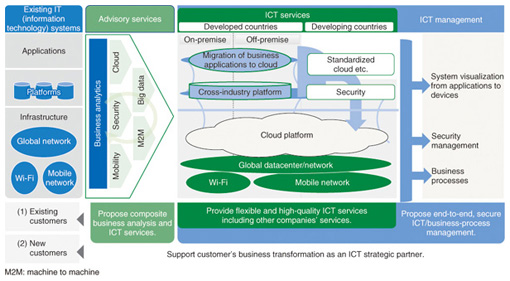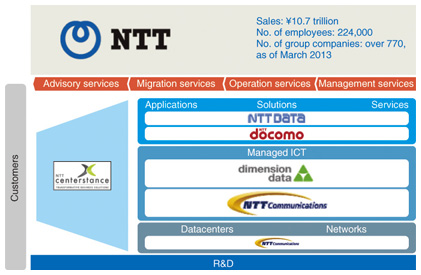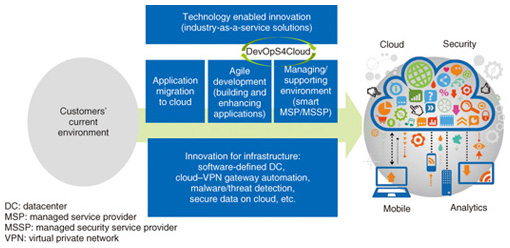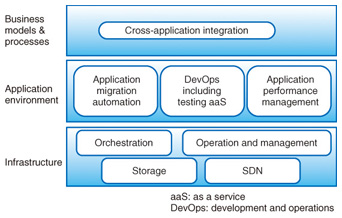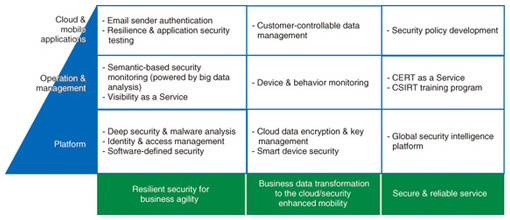 |
|||||||
|
|
|||||||
|
Feature Articles: NTT I3—Seeking to Actively Develop Global Cloud Services Vol. 11, No. 10, pp. 5–10, Oct. 2013. https://doi.org/10.53829/ntr201310fa1 NTT Group Global Business Strategy and NTT I3AbstractNTT’s Medium-Term Management Policy Towards the Next Stage calls for the early development and marketing of world-class cloud and security technologies in North America, the most competitive market in the world. To achieve this objective, NTT Innovation Institute, Inc. (NTT I3) was established on April 1, 2013 as a research and development center in North America. This article introduces the NTT Group’s global business strategy and the role of NTT I3 in executing this strategy. Keywords: global, security, cloud 1. IntroductionNTT’s Medium-Term Management Policy Towards the Next Stage, announced in November 2012, introduced the goal of becoming the value partner that customers continue to select. The policy also describes two pillars of this new effort that are central to achieving this goal: global cloud services as the cornerstone of NTT’s business operations, and highly competitive network services. Global business is the driver of NTT Group growth. The stated goals are to double global earnings over the next five years, and in 2016, to earn $20 billion, with more than 50% of corporate earnings coming from global business. To grow its global business, the NTT Group plans to enhance its consulting and solution-proposal abilities in order to implement effective solutions to its customers’ business problems through information and communications technology (ICT). Thus, in addition to providing existing ICT services, there is a need for boosting paradigm-shifting services with an emphasis on cloud services, mobility services, and advanced analysis of diverse business data for prediction purposes (business analytics). There is also a need for operating ICT services and business processes in an end-to-end manner and for creating strong relationships with customers as a path to new service provision. The need is likewise felt to provide flexible and high-quality services that can combine the customer’s existing information systems with NTT’s cloud service menu and even with services of other companies (Fig. 1).
The NTT Group has formulated a system that drives a full lineup of business areas combining networks, datacenters, managed ICT, applications, solutions, services, and research and development (R&D) (Fig. 2). As reflected in the phrase Next Value Partner for Transformation by Total Solution (NTT), the NTT Group seeks to gain the trust of its customers by offering differentiated services and technologies that can support the transformation of their business models.
NTT may be a trusted brand in Japan, but from a global perspective, it is ranked number 2 among Japanese companies and number 16 among all companies in all industries in the world as announced by Brand Finance in its brand rankings [1]. While this brand recognition is certainly not unfavorable, there is still much room for improvement. To gain trust on a global scale, it is essential that NTT invest aggressively in new fields such as cloud computing and security and expand its global business. 2. Purpose of establishing NTT I3NTT I3 was established on April 1, 2013 (Fig. 3) as part of the NTT Group’s push toward globalization as described above.
NTT I3 seeks to become a global hub of NTT R&D and to provide new service creation to support the growth of the NTT Group’s global business. To achieve this goal, it will focus on four activities, as summarized below. (1) Establish a market foothold: North America is considered to be an advanced region in terms of security, cloud computing, and other ICT technologies. By establishing a foothold in this market and developing competitive skills in North America, NTT I3 can expand to other regions where markets can be opened up and can enhance its competitive skills in a wider variety of regions. (2) Leverage the Silicon Valley ecosystem: Silicon Valley is a center of leading technology companies and a repository of information on cutting-edge technology. It is consequently an ideal location for developing strong partnerships with forward-looking companies and for quickly collecting information on advanced technologies. NTT I3 will pursue service development making best use of the advantages of this region. (3) Develop intellectual property (IP) for corporate global business: Being in close proximity to the North America market, NTT I3 aims to convert technologies matching the businesses of NTT Group companies in North America into IP as quickly as possible and to bring that IP to this market. The overall plan is to modularize this IP and market it globally. (4) Be a source of differentiation for the NTT Group: A key strength of the NTT Group is R&D, and the establishment of a center in North America is a major step forward for NTT in expanding its R&D. NTT I3 aims to raise the level of product differentiation in the NTT Group by promoting applied R&D that can only be carried out in North America based on market needs while incorporating the results of basic research and development at the NTT laboratories of NTT Holding Company. Furthermore, while some service development has traditionally been undertaken under the separate visions of the various NTT Group companies, the promotion of applied R&D by NTT I3 in the North American market is expected to contribute to group collaboration and to produce a synergetic effect among the NTT Group companies. 3. NTT I3 approach to R&DTo meet the needs and desires of more than 10,000 enterprise clients around the world, NTT I3 seeks to develop IP in cloud, security, mobility, and operations technologies with the aim of developing innovative services and providing superior operations (Fig. 4).
In particular, NTT I3 focuses on innovations that contribute to the business agility of our clients. Business agility is built on five capabilities: (1) Exploring innovative technology-enabled business models, (2) responding rapidly to emerging competitive threats, (3) improving the speed at which these business models can be brought to the marketplace, (4) dealing with regulatory, security, and privacy threats in an increasingly connected global marketplace, and (5) doing all of these at a price that provides value to their customers and stakeholders. Today’s organizations cannot compete successfully in the dynamic global marketplace without these capabilities. NTT I3 recognizes our clients’ critical need for business agility and therefore drives innovation in three layers. Innovations at the top layer should redesign our clients’ business models and/or business processes. Innovations at the middle layer should accelerate our clients’ activities of developing and operating new applications while providing up-to-date security protection. Innovations at the bottom layer should advance our infrastructure to provide services at software-speed while achieving high performance and security. For the present, NTT I3 will focus on service and product development in the areas of security and cloud computing. The following describes specific development efforts in these two key areas. 3.1 CloudA strong point of the NTT Group’s cloud is that a wide range of services can be provided. For example, the NTT Group can provide total customer support throughout the life cycle of cloud-migration planning, migration execution, and post-migration operations. These services cover all layers, i.e., the application, cloud platform, and network layers. Another strong point is that the NTT Group has an R&D department for cloud development. The NTT Group strategy seeks to leverage these strengths, and in line with that strategy, NTT I3 will work to develop IP that can extract the synergy among the wide range of services that the NTT Group provides (Fig. 5).
At present, NTT I3’s work in cloud computing can be divided into three main themes. The first theme is cloud migration support technology (migration technology). This technology is being developed to reduce barriers at the time of migration and to improve stability in performance. The second theme is big-data analysis technology for managing the performance of applications. With this technology, NTT I3 aims to help customers maintain high application performance by identifying the dependencies among multiple performance metrics of a complex cloud environment. The third theme is network and storage technologies for cloud computing. In particular, NTT I3 is working intently on software-defined networking (SDN) technology, which is essential to a service provider like NTT for creating differentiated services. For more details, please see the example of SND presented in “Networking at NTT I3 and Outlook of SDN” [2] in these Feature Articles. By approaching R&D in the above way, NTT I3 will first aim for growth in the NTT Group companies doing business in North America while also planning to roll out the IP developed and recognized in this market to developing countries and Japan itself sometime in the future. 3.2 SecuritySecurity measures and security analysis and management are undergoing changes due to a number of factors including changes in the types of threats and vulnerabilities, changes in the legal system and social demands, and the influence of stakeholders. The NTT Group aims to establish a permanent position for itself as a top-class security integrator in the world by providing comprehensive managed security services encompassing consulting, operations, and platforms. To support this endeavor, NTT I3 plans to construct a global security platform that will serve to enhance the security businesses of NTT Group companies. This plan includes the development of a Deep Security Analysis Platform for analyzing threats and an NTT Global Security Intelligence Platform for disseminating information on threats and vulnerabilities (Fig. 6). Incidentally, there is already a history at NTT I3 of analyzing security intelligence in collaboration with NTT’s Computer Security Incident Response and Readiness Coordination Team (NTT-CERT) and Computer Security Incident Response Team (CSIRT) organizations throughout the world. NTT I3 aims to leverage its experience in these activities to research and develop advanced security technologies. A more detailed description of this endeavor can be found in the Feature Article entitled “Enhancing Security Analysis at NTT I3” [3] in this issue.
References
|
|||||||

